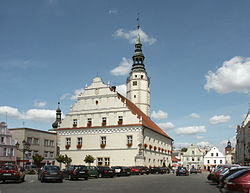Głogówek
| Głogówek Oberglogau |
|||
|---|---|---|---|

Town Hall on Main Square
|
|||
|
|||
| Coordinates: 50°20′38″N 17°52′2″E / 50.34389°N 17.86722°E | |||
| Country |
|
||
| Voivodeship | Opole | ||
| County | Prudnik | ||
| Gmina | Głogówek | ||
| Established | 11th century | ||
| Town rights | 1275 | ||
| Government | |||
| • Mayor | Andrzej Jan Kałamarz | ||
| Area | |||
| • Total | 22.06 km2 (8.52 sq mi) | ||
| Elevation | 212 m (696 ft) | ||
| Population (2006) | |||
| • Total | 5,816 | ||
| • Density | 260/km2 (680/sq mi) | ||
| Time zone | CET (UTC+1) | ||
| • Summer (DST) | CEST (UTC+2) | ||
| Postal code | 48-250 | ||
| Area code(s) | +48 77 | ||
| Car plates | OPR | ||
| Website | http://www.glogowek.pl | ||
Głogówek [ɡwɔˈɡuvɛk], German Oberglogau (earlier Klein Glogau or Kraut Glogau, Czech: Horní Hlohov) is a city in Poland located in Opole Voivodeship in Upper Silesia. The city lies approximately 35 kilometres (22 miles) from Opole, the capital of the voivodeship, and is about 10 km (6 mi) from the Czech border. The name of the city comes from the Polish word głóg, meaning hawthorn. The plant grew quite thickly in the area when the city was founded.
Since 2009 the town has been bilingual in German and Polish, a substantial German population having remained in the area after Silesia was ceded to Poland and the end of World War II.
It is often said that the first historical mention of Głogówek was in 1076, but this is now known to be false. The Russian sources frequently quoted citing the city's 11th century founding were misinterpreted, referring instead to a Lower Silesian town, Głogów, with a very similar name. This village, first mentioned in 1010, was located some distance from Głogówek and later became a fortified castle by the Oder and a major city. However, given the ages of the Russian texts, a mistake in identifying the first historical mentions of the two villages is understandable. At the time, military conflict in the region was common, and the use of the Głogów fortress may very well have inspired the names of smaller villages in the surrounding area, causing the confusion.
The first unequivocal historical mention of Głogówek in a Silesian source dates from 1212. This source is a list of villages which were in the tithing area of the Leubus Cloister. The village was referred to as "Glogov" in the Latin text, which describes, in some detail, the boundaries of the village. This description could only apply to the present-day village, and is considered to be the first unambiguous mention of Głogówek. Town privileges were granted to Głogówek in 1275. Another error in Silesian record-keeping states that Głogówek, still a fairly small town, had 12 official representatives, a number much too large for a city of that size. Wrocław, a much larger city, had only five at the time. The city was later granted German town privileges as well.
...
Wikipedia



